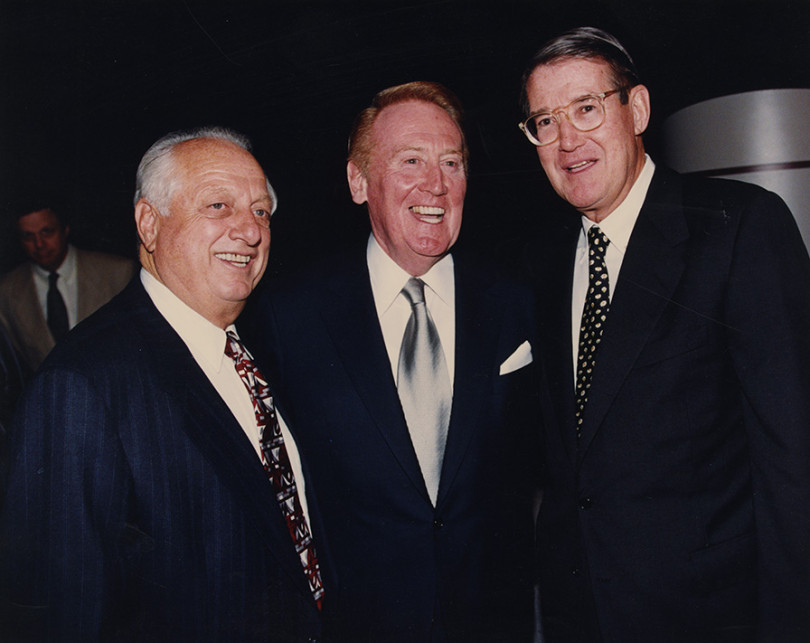
November 20, 1997, Leonard H. Goldenson Theatre at the Academy of Television Arts and Sciences headquarters, No. Hollywood, CA, (L-R) Dodger Vice President Tom Lasorda; Hall of Fame Dodger broadcaster and honoree Vin Scully; Dodger President Peter O’Malley. For 67 seasons, Scully was with the Dodgers.
Dodger Organization Thrived on Stability
Stability is the one word that stands out when the Dodger organization was led by the O’Malley family for 50 years.
During those five decades, the Dodgers stayed the course, despite the inherent ups and downs of an industry that experiences wins and losses. This they did in a variety of areas, including on field personnel, front office executives, club broadcasters, team doctors, and Spring Training headquarters at Dodgertown, Vero Beach, Florida.
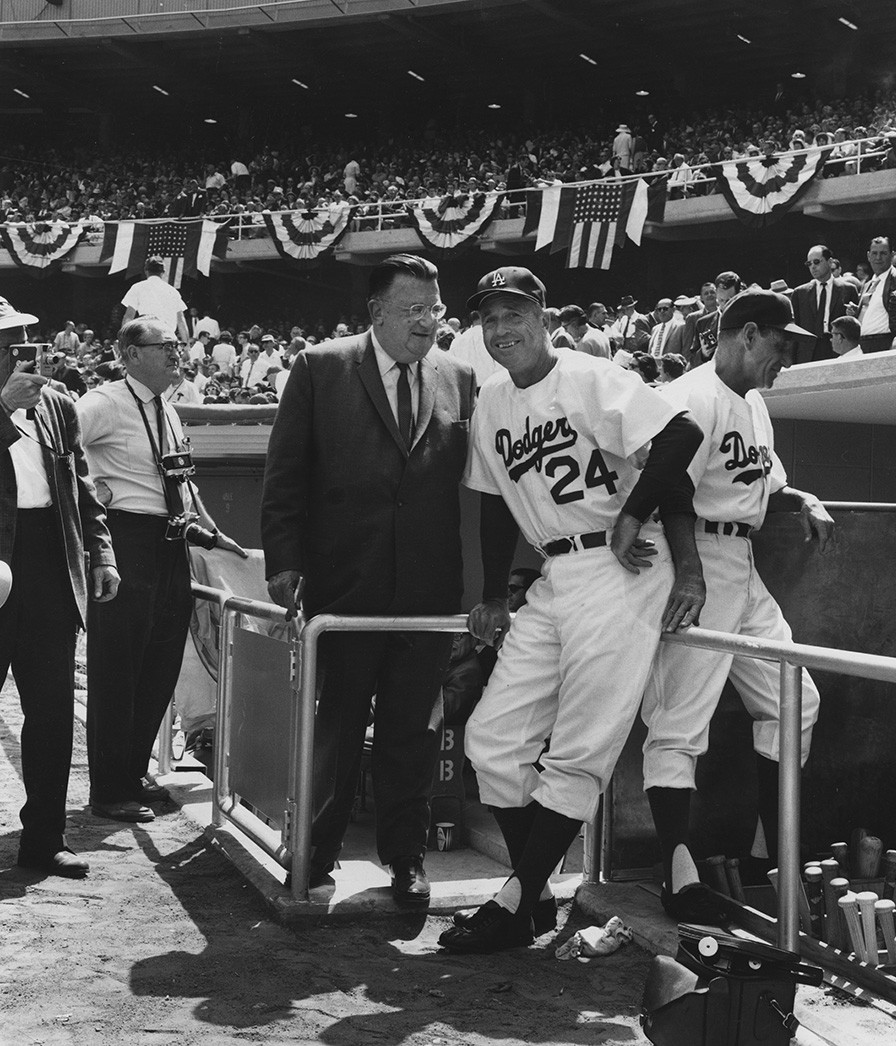
April 10, 1962, Dodger President Walter O’Malley and Dodger Manager Walter Alston celebrate the first Opening Day at Dodger Stadium. Alston and the Dodgers won the only World Championship at Dodger Stadium in 1963. Alston guided the Dodgers for 23 seasons, winning 2,040 games. A baseball lifer, he spent 10 years as a Dodger minor league manager before he took the reins of the Dodgers big league club in 1954. Alston was inducted into the National Baseball Hall of Fame in 1983.
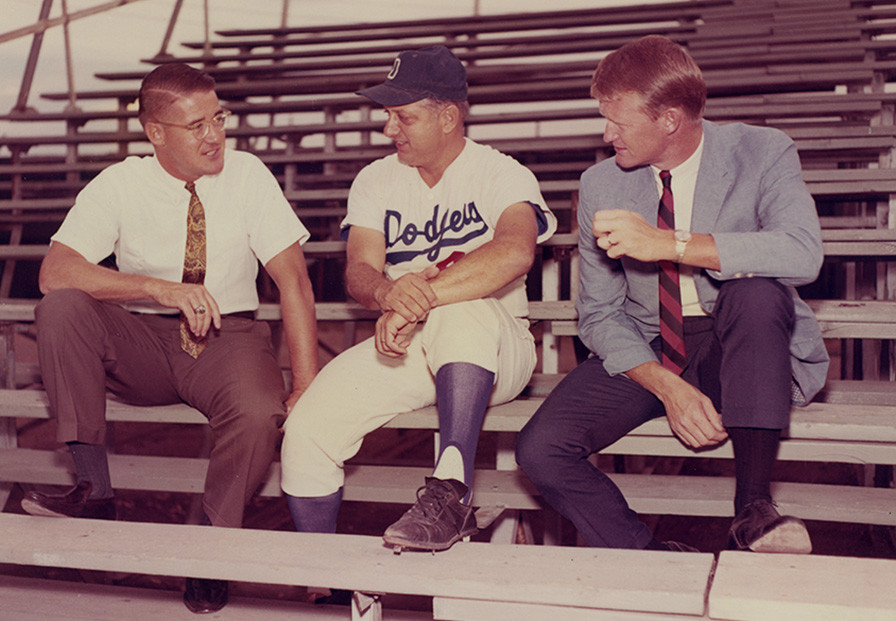
August, 1967, Ogden, Utah, Dodger rookie team in the Pioneer League, (L-R) Dodger Vice President, Stadium Operations Peter O’Malley; Ogden Manager Tommy Lasorda; and Odgen Dodgers General Manager Gordon “Dutch” Belnap. In 1973, Lasorda had worked his way up to the major league coaching staff under Manager Walter Alston.
In 1985, A.S. “Doc” Young, sports columnist of the Los Angeles Sentinel wrote: “While the O’Malley’s — Walter and Peter, father and son — have built a model franchise in Los Angeles…The Dodgers have built a modern stadium…maintained it perfectly, promoted their team with great class, dedication, and imagination…the Dodgers are in fact, the most valuable franchise in Major League Baseball, challenged, only, I’d say, by the New York Yankees…”.
From 1951-1997 on the field, the Dodgers were first in the National League with six World Championships, total wins, winning percentage, and most pennants (13). The Dodgers were second in those categories only to the American League’s New York Yankees (who had 54 more wins in those 47 seasons).
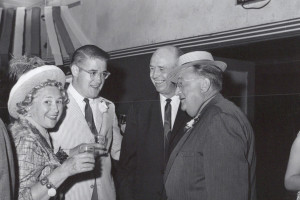
St. Patrick’s Day, circa 1960s, Dodgertown, Vero Beach, Florida, (L-R) Kay O’Malley; Peter O’Malley; Dodger Manager Walter Alston; and Dodger President Walter O’Malley. After managing in the Dodger minor league system, Alston was named Dodger manager for the 1954 season and won the club’s first World Championship in 1955. The Hall of Fame manager would win four World Series for the Dodgers (1955, 1959, 1963 and 1965).
In short, the Dodgers in the O’Malley era employed four managers – Charlie Dressen, Walter Alston, Tommy Lasorda and Bill Russell. Alston served the Dodgers as manager for 23 seasons, while Lasorda spent 20 seasons as manager with the club, winning a combined 3,239 games. Both were inducted into the National Baseball Hall of Fame. Several major league teams, including the New York Yankees, have employed a record three managers in one season!

Circa late 1950s, (L-R) Dodger President Walter O’Malley; Hall of Fame Dodger Manager Walter Alston; and Dodger Executive Vice President Buzzie Bavasi. Alston proudly signs one of his 23 one-year contracts during his time as Dodger manager from 1954 to 1976.

The Dodgertown, Vero Beach, Florida auditorium, circa 1950. The speaker on the stage is Dodger Vice President Fresco Thompson, reviewing information required for the minor league players. Former major league second baseman Thompson was a minor league manager and assistant farm director before newly named Dodger President Walter O’Malley named him as Vice President overseeing the minor leagues in 1950.
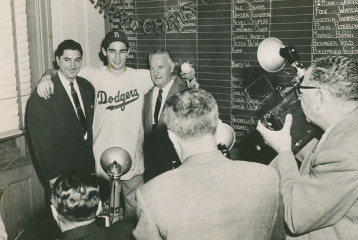
December 14, 1954, (L-R): Al Campanis, Dodger scout; Sandy Koufax; and Fresco Thompson, Dodger Vice President in charge of minor league operations (1950-1968). The Brooklyn Dodgers announced at a press conference the signing of left-handed pitcher Sandy Koufax who first joined the Dodgers in 1955.
From 1950-1997, the Dodgers employed four General Managers, Buzzie Bavasi, Fresco Thompson, Al Campanis, and Fred Claire. In the same period, they had three minor league farm directors – Fresco Thompson, Bill Schweppe, and Charlie Blaney. The Dodgers in this time had three scouting directors, Al Campanis, Ben Wade and Terry Reynolds. Along with Peter O’Malley, longtime Latin America Dodger scout Ralph Avila created and developed the state-of-the-art Dominican Republic Campo Las Palmas baseball academy, which opened March 21, 1987. Avila was named Dodger Vice President, Campo Las Palmas in 1991 and was affiliated with the Dodgers for more than 50 years. In public relations and promotions, the baton was only passed from Arthur E. “Red” Patterson to Fred Claire. In marketing, the mantle went from Merritt Willey to Barry Stockhamer.
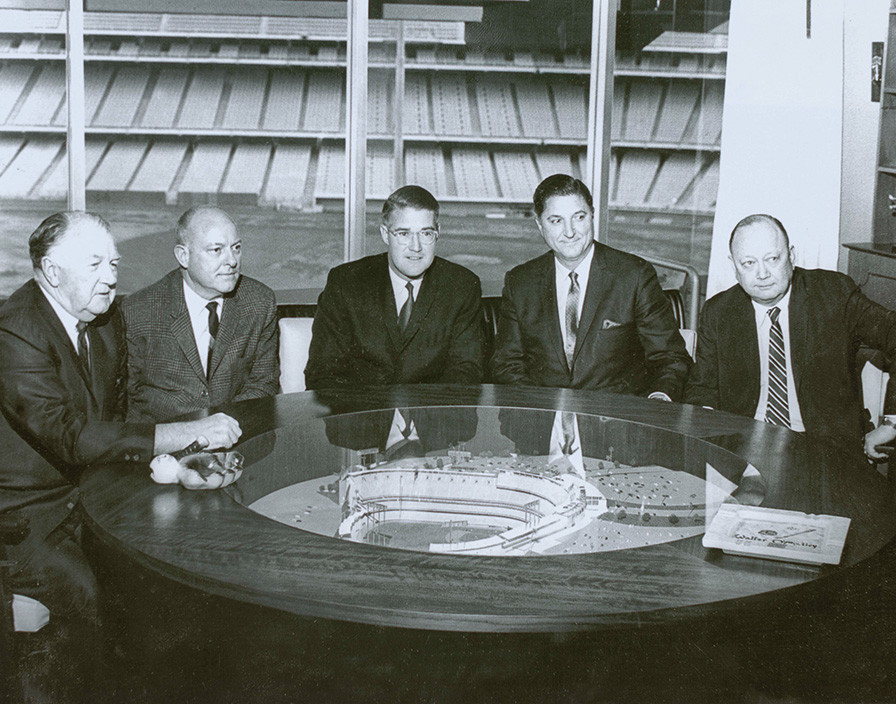
Peter O’Malley, center, was named Executive Vice President of the Los Angeles Dodgers in December, 1968 and meets with four Dodger Vice Presidents (L-R) Red Patterson, public relations and promotions; William P. Schweppe, minor league operations; Al Campanis, player personnel and scouting; and James Bealle, Radio-TV.
Two Hall of Fame broadcasters, Vin Scully and Jaime Jarrin, both were voices of the Dodgers for more than 60 years. Other broadcasters hired by the O’Malley family include Jerry Doggett who spent 32 years with the Dodgers, while Ross Porter was with the club for 28 years, Rene Cardenas for 21 years, Rick Monday still active since 1993, and Pepe Yniguez still active since 1998.
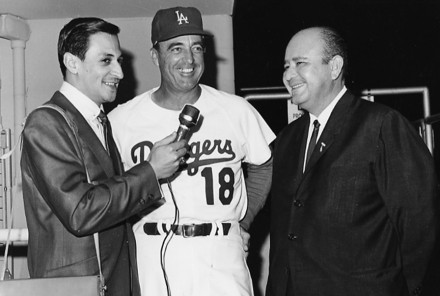
Circa, mid-1960s, (L-R) Jaime Jarrin, Dodger Spanish-language broadcaster; Preston Gomez, Dodger third base coach; and Jose Garcia, Dodger Spanish-language broadcaster. Hall of Fame broadcaster Jarrin first broadcast for the Dodgers in 1959. He and Garcia worked together from 1962-1972. Jarrin amassed 64 seasons for the Dodgers behind the mike.
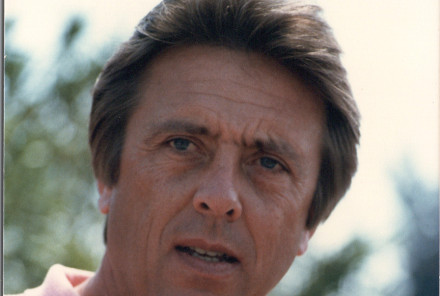
Dodger All-Star center fielder Rick Monday played in three World Series for the Dodgers (1977, 1978 and 1981) after being acquired in a trade from the Chicago Cubs. Monday holds a special place in baseball history when he saved an American flag from being burned in Dodger Stadium, April 25, 1976. Since 1993, Monday has been a popular broadcaster for the Dodgers.
Many scouts and administrative assistants served the Dodgers for multiple decades. Former Dodger players became coaches and instructors within the organization, further advancing continuity.
In 1970, Dodger President Peter O’Malley named former Dodger Cy Young Award-winning pitcher Don Newcombe to lead baseball’s first Community Relations department. He remained with the Dodgers until his passing in 2019. Another popular Dodger, “Sweet” Lou Johnson returned to the team in 1980 to work in Community Relations. He stayed with the front office for nearly four decades.
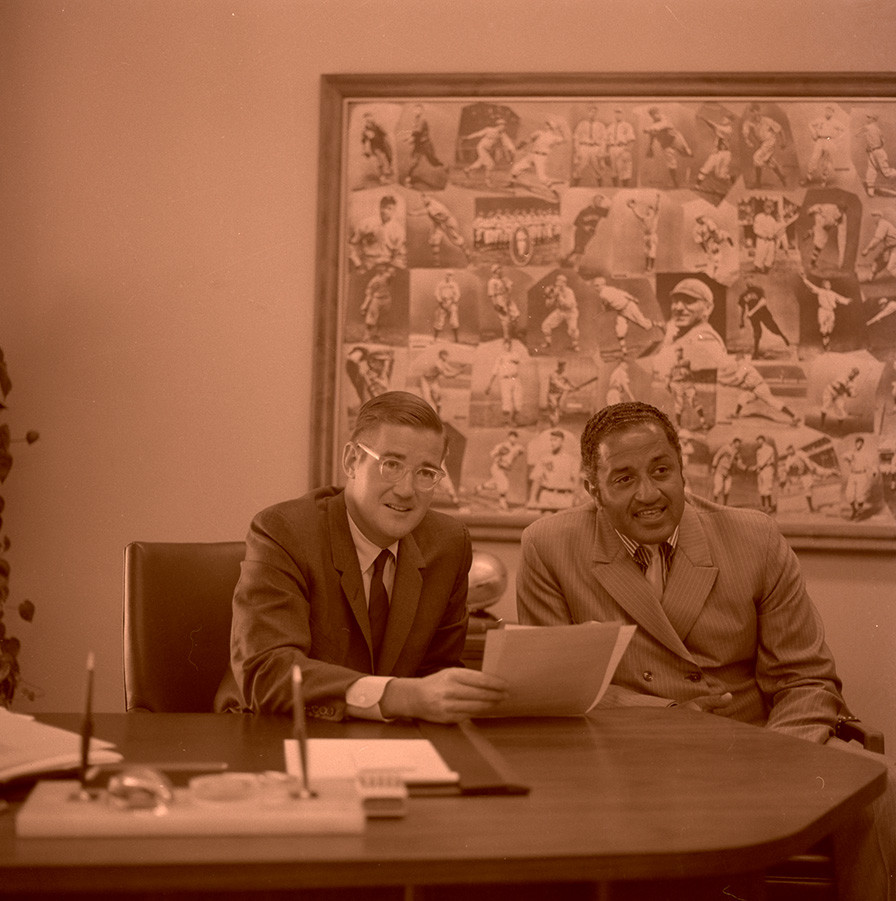
May, 1970, Dodger great pitcher Don Newcombe (right) had been hired by Dodger President Peter O’Malley (left) to create baseball’s first Community Relations Department with Newcombe as director. Newcombe, who won National League MVP, Cy Young Award, and NL Rookie of the Year honors, frequently spoke to groups and counseled individuals about alcohol abuse.
Dr. Frank Jobe and Dr. Robert Woods were longtime team doctors for the Dodgers. In 1958, Walter O’Malley hired Dr. Woods as one of his first acts in Los Angeles. Dr. Woods was with the Dodgers through 1986.
Dr. Jobe started as a consultant to the Dodgers in 1964 and became their orthopaedic physician for 40 years (1968-2008), working closely with Dr. Robert Kerlan, who worked with the Dodgers from their Los Angeles arrival. Innovative athletic trainer Bill Buhler was with the Dodgers for 39 years (1957-1995).
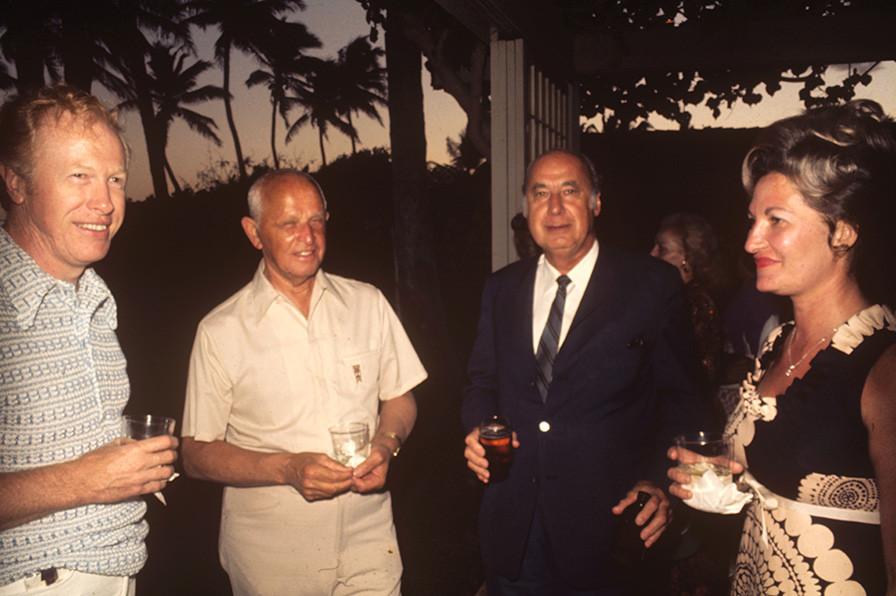
1972 MLB Winter Meetings, Honolulu, Hawaii, (L-R) Dr. Frank Jobe, longtime Dodger orthopedic surgeon; Harry Bardt, member, Dodger Board of Directors; Dr. Robert Woods, Dodger team doctor (1958-1986); and Beverly Jobe, wife of Dr. Frank Jobe; attending a reception.
Many employees, both in the front office and game-day personnel at Dodger Stadium, crossed the 20, 30 and even 40 year-plus milestone of working for the Dodgers.
In 1982, Peter O’Malley explained his thinking to the New York Times, “You try to find people who fit in. If you don’t make too many mistakes in hiring, you don’t have to do so much firing.” Jane Gross, New York Times, January 4, 1982

Circa late 1990s, Dodgertown, Vero Beach, Florida, (L-R) Tommy Lasorda; and Dodger Vice President, Campo Las Palmas, Ralph Avila who headed all Dominican Republic scouting and development.
In the summer issue 1989 of Phi Gamma Delta magazine, William Martin III wrote, “There are many and various reasons that Forbes magazine (April 12, 1982) has called the Dodgers ‘the best-run franchise in all of baseball’…Steadfastness and purpose at the top of the organization is one of the things that separates the Dodgers from other teams.” William Martin III, Summer issue 1989, Phi Gamma Delta magazine
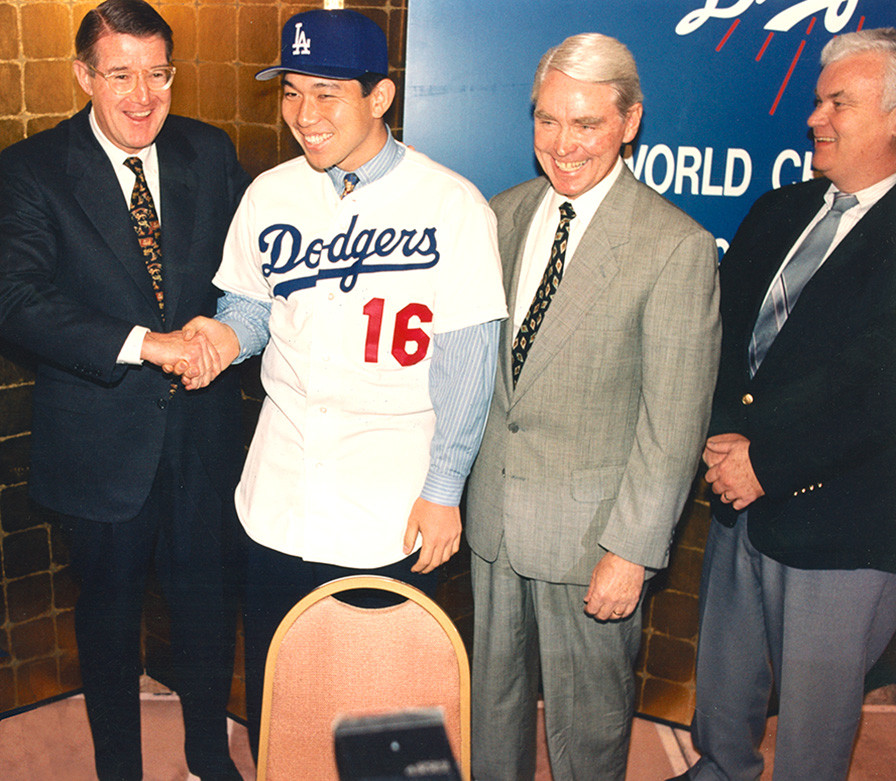
A happy day in Dodger history upon the signing of Japan-born right-handed pitcher Hideo Nomo. This was at the press conference to introduce Nomo on February 13, 1995 at the New Otani Hotel, Little Tokyo, Los Angeles. (L-R) Dodger President Peter O’Malley; Hideo Nomo; Dodger Executive Vice President and General Manager Fred Claire; and Dodger Director, Minor League Operations Charlie Blaney.
Dodger first baseman Steve Garvey said of Peter O’Malley, “He’s the perfect example of the contemporary young owner with a business mind…he believes in stability. By knowing his people, he knows how to motivate them and get the most out of them. With the Dodgers, familiarity breeds success.” Dave Anderson, New York Times, October 25, 1981
In 1985, O’Malley discussed his philosophy of running the Dodger organization, “Baseball has changed more in the last five or six years than in the preceding 25. But I decided pretty early to take the long-term view. I knew I would be in the game a long time…I had a long-term commitment. Good common sense and good judgment…a pretty good philosophy…(I am) the president, the chief executive officer…It’s my responsibility to make sure the business is run well…We’re business — big business, successful business, profitable business, but we have an impact on children, on the community, on our fans. We have a responsibility.” Pam King, Los Angeles Herald Examiner, April 14, 1985

Circa 1992, Dodger Stadium, Dodger President (fourth from left) with club Vice Presidents (L-R) Bob Graziano; Fred Claire; Barry Stockhamer; Ralph Avila; Walter Nash; Tommy Hawkins; and Bob Smith.
In 1981, O’Malley told Los Angeles Times sports editor Bill Shirley, he wants to be aware of everything going on in the Dodger organization. “I don’t want to be surprised. I don’t want to hear about anything, whether it’s scouting, minor leagues, promotions, or tickets, through the grapevine. It works. If you know what’s happening and know it quickly, little problems don’t become big problems.” Bill Shirley, Los Angeles Times, December 27, 1981

October 4, 1955, Yankee Stadium, New York, (L-R) Dodger President Walter O’Malley and Dodger Manager Walter Alston embrace moments after the Dodgers won their first World Championship as the Dodgers defeated the New York Yankees in Game 7 of the 1955 World Series. O’Malley had named Alston manager the previous year.
AP Photo
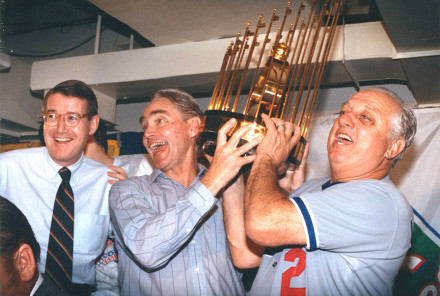
October 20, 1988, Visitor’s Clubhouse, Oakland-Alameda Coliseum, Oakland, CA, (L-R) Dodger President Peter O’Malley, Executive Vice President, Player Personnel Fred Claire, and Dodger Manager Tommy Lasorda share the joy of winning the 1988 World Championship. The Dodgers defeated the Oakland Athletics in five games to win the 1988 World Series.
Mike O’Connell writing for the University of Pennsylvania magazine in 1982, “The (Dodger) franchise, symbolized by the aura of ‘Dodger Blue,’ has been a stable, consistent winner for decades, both on the field and at the gate…One thing O’Malley does not believe in is besieging his players with his presence. He is a low profile, low pressure owner who leaves the managing to the manager, the playing to the players, and the cheerleading to the fans.” Mike O’Connell, 1982, University of Pennsylvania magazine
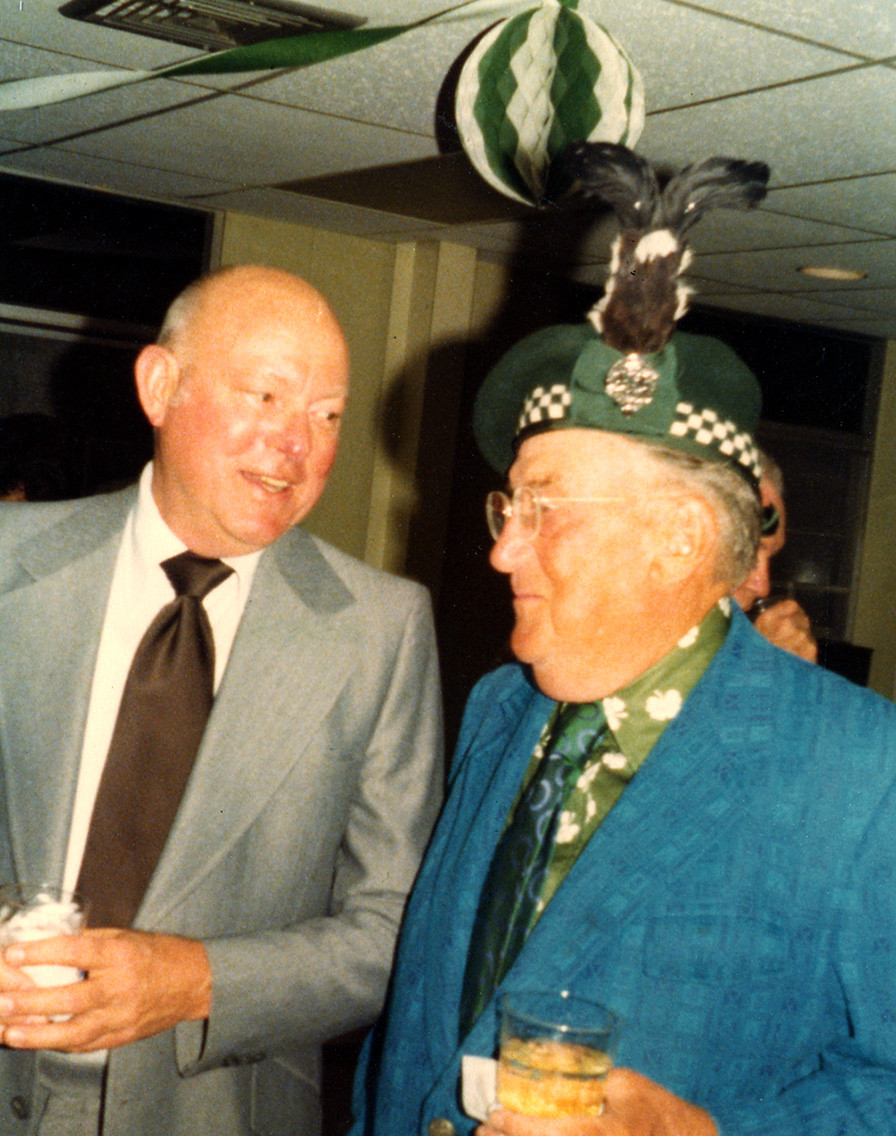
1977 St. Patrick’s Day party, Dodgertown, Vero Beach, Florida, (L-R) Dodger Vice President, Minor Leagues, William P. Schweppe; and Dodger Chairman of the Board Walter O’Malley. Schweppe, who started in the Brooklyn Dodger organization in 1946, was an integral part of the Dodger minor league operations from 1958 until his retirement as vice president in 1987.
Forbes magazine in a story about the Dodgers in 1982: “O’Malley’s management style looks especially well suited to the times. Investing heavily in his scouting efforts and in his farm system doesn’t guarantee O’Malley victory in all his salary battles, but it positions him well against his competitors. Management by tantrum in the Steinbrenner style, with its quick payoffs in headlines and ego rewards, may be where baseball is headed, but O’Malley’s management by thought is surely where it ought to be going.” John Merwin, Forbes magazine, April 12, 1982

